Updated: January 31, 2025
Written by Adam Graham
Cristina has more than 4 years of experience in the remodeling and home design sector. She joined Fixr.com in 2017 and has since been working constantly with industry experts to bring the most accurate and reliable information regarding news, trends, and advice to homeowners and other industry pros. Her work has appeared in major industry publications, like Forbes, Realtor.com and the official publication of the National Kitchen & Bathroom Association.
Learn moreReviewed by Cristina Miguelez
Mudrooms add function and storage to your home. They were once primarily used in northern and midwestern homes as a secondary entrance for farmers and workers who needed a place to shed muddy boots and get clean. Today, many homeowners are adopting it for their use. This casual second entrance can still be used to keep muddy boots and outer things out of your home. It can also be used for storage, organization, or an extension of your laundry room.
Mudrooms can be converted from existing areas. They can also be built onto the home as an addition. They come in several sizes and hold many things, leading to a range of costs. The average cost range for a mudroom addition is $12,000 to $18,000, with most homeowners paying $14,500 for a 60 sq.ft. mudroom addition with built-in cubbies for 4, new flooring, and a baseboard heater. This project’s low cost is $3,600 for a 36 sq.ft. mudroom conversion from an existing space with ready-made shelves and new flooring. The high cost is $36,000 for a 120 sq.ft. addition on the back of the home with stone flooring, custom built-in cubbies and benches, an HVAC system extension, insulation, sink, washer/dryer, and countertops.
Mudroom Addition Cost
| Cost to a Add Mudroom to a House | |
| National average cost | $14,500 |
| Average range | $12,000-$18,000 |
| Low-end | $3,600 |
| High-end | $36,000 |
What Is a Mudroom?
A mudroom can have many purposes, depending on the needs of your family and home. Traditionally, this space has been seen as a casual second entrance designed for the family. It is meant to be where you take off and leave muddy outdoor boots, clothing, and belongings so that they do not enter your home. The mudroom is usually clad in materials that are easily cleaned and cared for and are not impacted by mud, snow, sand, and other debris. This includes flooring materials like porcelain tile and wall claddings like beadboard. Today, most mudrooms also include storage for things you most likely use when going outside, such as sports equipment, coats, boots, dog leashes, and children’s school backpacks. Most mudrooms are small, usually under 120 sq.ft., but you can have a larger space if needed.
Cost of Adding a Mudroom by Size
The average mudroom is not very large and may sometimes be considered a micro addition. Typically, mudrooms range between 36 and 70 sq.ft. but may be as large as 100 to 120 sq.ft. when adding laundry equipment or a utility sink. Consider whether you are making it an indoor addition when determining your mudroom’s size, meaning taking an existing space and turning it into a mudroom or building onto the home. Consider a full-scale addition if you want a larger space for storage, laundry facilities, and a dedicated entrance. If you only need a small area, closet conversions and other interior additions can be the right choice. Most mudrooms have an average cost range of $100 to $200 per sq.ft. for micro additions or interior conversions and an average cost range of $100 to $300 per sq.ft. for slightly larger additions. This can make a small mudroom addition affordable for many homeowners.

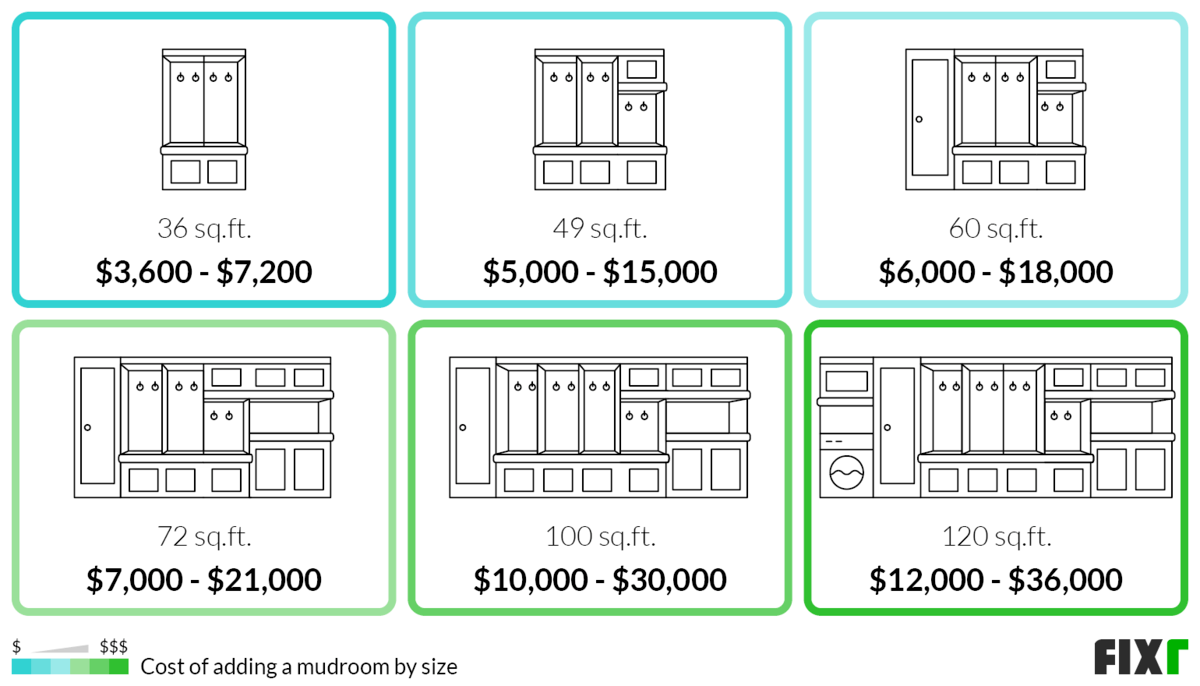
| Size | Cost (Labor Included) |
| 36 sq.ft. (6’ x 6’) | $3,600 - $7,200 |
| 49 sq.ft. (7’ x 7’) | $5,000 - $15,000 |
| 60 sq.ft. (7¾’ x 7¾’) | $6,000 - $18,000 |
| 72 sq.ft. (8½’ x 8½’) | $7,000 - $21,000 |
| 100 sq.ft. (10’ x 10’) | $10,000 - $30,000 |
| 120 sq.ft. (10’ x 12’) | $12,000 - $36,000 |
Mudroom Addition Cost by Location
Mudrooms can be added to many areas. Some can be added to your home’s interior, while others require you to make an addition. Each has pros and cons, particularly in function, space, and limitations. Because of this, the location may impact the project’s cost.


| Location | Cost (Labor Included) |
| Front Door | $3,600 - $7,200 |
| Closet | $3,600 - $7,200 |
| Garage | $3,600 - $10,000 |
| Kitchen | $3,600 - $10,000 |
| Living Room | $3,600 - $10,000 |
| Outdoor | $3,600 - $30,000 |
| Back | $4,900 - $36,000 |
| Basement | $7,350 - $25,000 |
| Porch | $20,000 - $40,000 |
Front Door Mudroom Addition
The average cost of a front door mudroom addition is $3,600 to $7,200. While most mudrooms are considered secondary entrances, it sometimes makes the most sense to include a small mudroom at the front door. In this case, the addition is typically made to the home’s interior. It can be done in several ways. You can section the area inside the front door to make a separate “room” or vestibule where people can enter and remove outer clothing. You can also have a mudroom inside the home to one side of the front door. Installing coat hooks, benches with interior storage, and wall cubbies keep the entryway clean and organized no matter how much traffic it gets.
Turning a Closet Into a Mudroom
The cost to turn a closet into a mudroom averages $3,600 to $7,200. This is a common conversion in small spaces. If you have a closet located near enough to an entrance that it makes sense for it to become a mudroom, converting it can add function. The conversion usually consists of opening and removing the existing closet. This typically means removing the door and walls and framing it in from the space. From here, it is a matter of outfitting it with the storage typically used in a mudroom like benches, lockers, or cubbies.
Adding a Mudroom to a Garage
The cost to add a mudroom to a garage ranges from $3,600 to $10,000. If the garage is your family’s most frequently used entrance into the home, it makes sense to convert part of it into a mudroom. Garage mudroom additions can be done in many ways. Some convert the area where the garage connects to the main home into the mudroom. Others add a mudroom area to one end near where they enter. Things to include in this conversion are lockers, cubbies, or benches because these keep the garage organized and uncluttered so that it can still be used for its original purpose.
Mudroom in a Kitchen
Adding a mudroom area to a kitchen costs $3,600 to $10,000. If your kitchen has an entrance to the backyard or side of the house, it makes sense to create a mudroom area. Unless your kitchen is extremely large, you can likely only add a mudroom area of up to 50 sq.ft. Typically, this includes creating a small area with cubbies or benches, easy-to-care-for flooring, and storage organization. You could line two walls with cubbies or lockers or set up a mudroom area on one side, depending on the kitchen layout. Change the flooring between the two sections if you want the space to look separate from the kitchen.
Mudroom in a Living Room
Adding a mudroom in a living room costs $3,600 to $10,000. If your living room exits outdoors, adding a small mudroom area can keep it clean and organized. You can set this up in several ways, depending on your living room’s layout and entrance. One method is to create a small area inside the door lined with lockers, benches, or cubbies on either side. You may create a mudroom area along one wall inside the door. You may consider changing the flooring to set it apart from the living room, using a low-maintenance floor material.
Outdoor Mudroom
The cost of an outdoor mudroom ranges from $3,600 to $30,000. Like the outdoor kitchen, the outdoor mudroom can be an attractive addition to many homes. If your family spends a lot of time outdoors, an outdoor mudroom can help you stay organized and keep your interior clean. Outdoor mudrooms often have patio pavers and outdoor storage options. It is also common to have an outdoor shower area or foot bath for cleaning muddy feet before entering the home. Storage may be for outdoor equipment, such as shovels, rakes, garden shoes, and backyard sports equipment.
Adding a Mudroom to the Back of a House
Adding a mudroom to the back of a house costs $4,900 to $36,000. Adding a mudroom onto the back of your house is considered a full mudroom addition. You can do this as a micro addition, meaning a small bump-out containing a doorway and your storage. You can also do this as a full-sized home addition. In this last case, you must consider adding HVAC systems, insulation, and overall construction. Bump-outs and micro additions do not need the same level of construction as a full addition, so they can be done more cheaply.
Basement Mudroom
The cost of a basement mudroom averages $7,350 to $25,000. If you have a walkout basement that exits to the outdoors, you may want to consider putting a mudroom here. Basement mudrooms have higher costs than mudroom additions in other areas. This is due to the finishing and waterproofing that must be done first, plus the higher costs of moving and rerouting plumbing and electrical work through the basement. Exposed pipes and wires must be moved or encased during the remodel. Basement mudrooms are not practical for true basements because they are designed to be next to an entrance.
Convert a Porch to a Mudroom
The average cost to convert a screened porch to a mudroom is $20,000 to $40,000. You can convert an existing screened porch into a four-season room as a second entrance to your home as a mudroom. Because these spaces are typically much larger than the average mudroom, the conversion cost is much higher. Your total costs depend on whether you have a foundation and what roof or structure the area has. Extending heating and cooling to the area, insulating, and building walls can mean this project becomes a much larger addition than the average mudroom and has higher costs.
Mudroom Addition Cost Breakdown
It can be helpful when building a mudroom to break it into basic components. This begins with framing the space and ends with the finishing treatments, such as storage, seating, and countertops. Not all mudrooms need the same level of work. If you add a mudroom area to an existing space, the construction is already done, and you get straight to adding the lockers, storage, and other attributes. However, construction is your first step for a completely new space, garages, and basements. Below is the average cost breakdown for the most common parts of the mudroom. Remember your mudroom may not have all these components.


| Mudroom Part | Cost (Labor Included) |
| Flooring | $2 - $214/sq.ft. |
| Walls | $5 - $33/sq.ft. |
| Countertops | $20 - $250/sq.ft. |
| Construction | $25 - $60/sq.ft. |
| Additional Storage | $20 - $3,800/item |
| Bench | $80 - $2,000/item |
| Plumbing | $150 - $4,000/item |
| Custom Lockers | $500 - $1,500/linear foot |
Mudroom Flooring Cost
You can use many flooring types for the mudroom. Choose a floor that can withstand heavy use because mudrooms are designed to be the casual entrance. A mudroom floor should be easy to clean, capable of hiding dirt, non-skid when wet, and require no special cleaners or sealers. Numerous flooring options work well in mudrooms, making it possible to find one that fits your decor and needs. The most commonly recommended materials for mudrooms include porcelain tile, which is non-porous and easy to care for, and some types of rubber and slate flooring. Vinyl is another popular choice for low-cost installations, but it does not last as long as other materials. These are low-maintenance and unlikely to be damaged by regular mudroom use.
You can also install other materials. Concrete should be sealed in a mudroom to prevent staining. If you choose hardwood, put down mats to absorb water or salt from the outdoors to prevent damage. Cork is another material that does well with water resistance but may stain, so use mats at the door with this material. You can also consider a brick floor for a unique appearance. Reclaimed bricks can give your mudroom character, while newer, thinner bricks can be installed more like tiles for a lower cost.
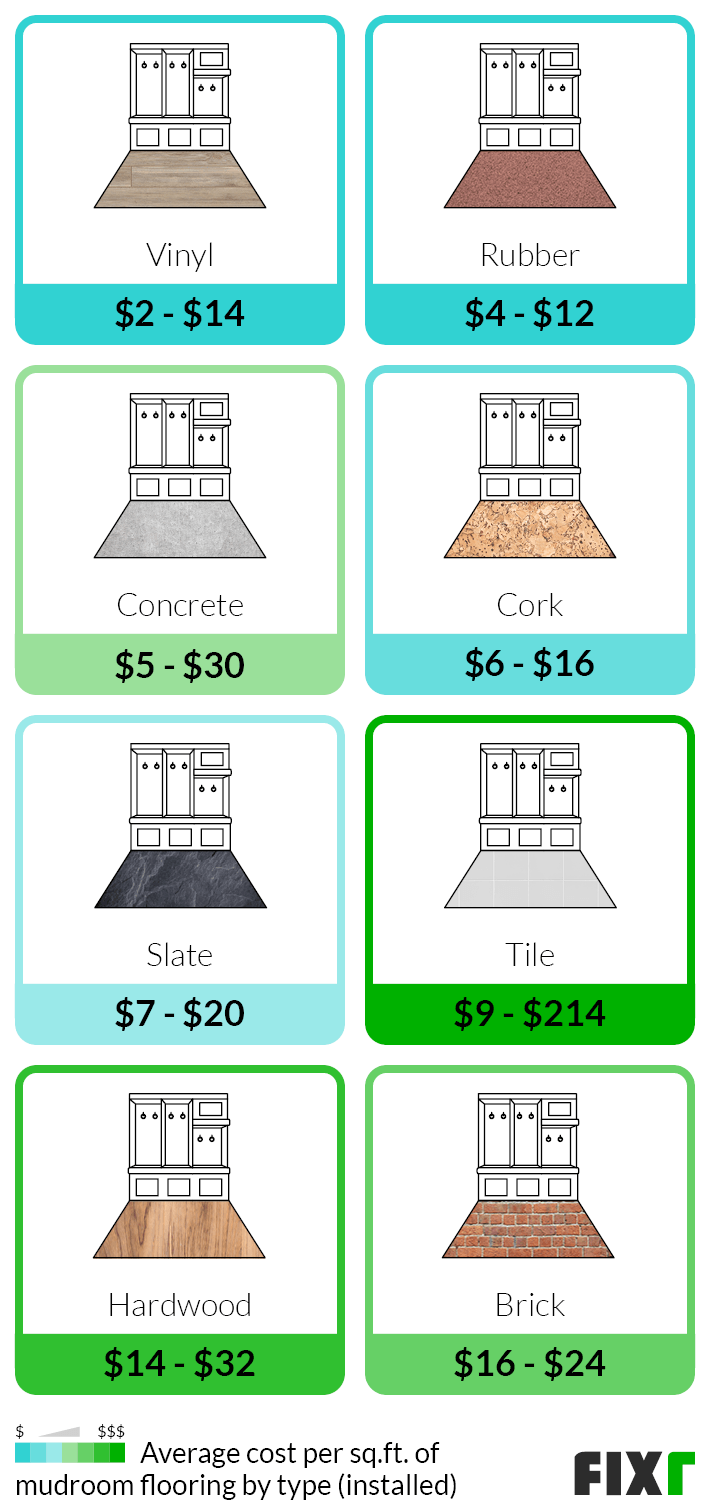
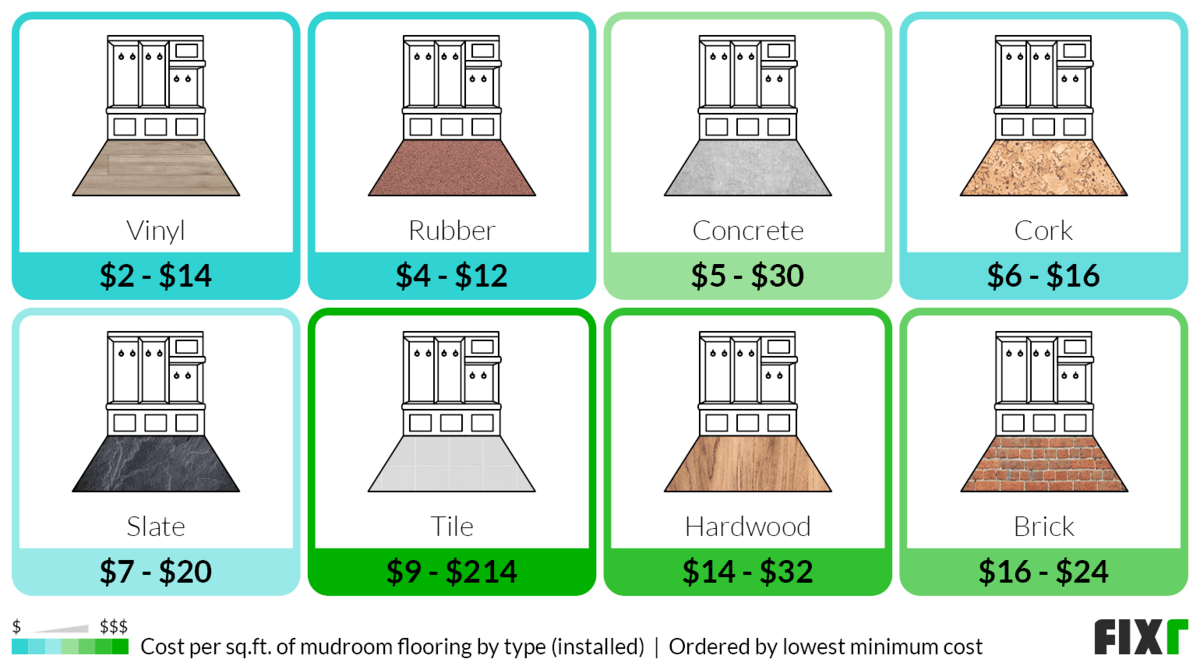
| Flooring Type | Cost per Sq.Ft. (Installed) |
| Vinyl | $2 - $14 |
| Rubber | $4 - $12 |
| Concrete | $5 - $30 |
| Cork | $6 - $16 |
| Slate | $7 - $20 |
| Tile | $9 - $214 |
| Hardwood | $14 - $32 |
| Brick | $16 - $24 |
Mudroom Walls Cost
It is common for many mudrooms to have the walls used for lockers, cubbies, coat hooks, and other storage options. However, you may have some wall areas that are not covered. While you can go with a simple paint finish, you can also choose various wall features, including board and batten for a cottage style or wall panels for something more elegant.

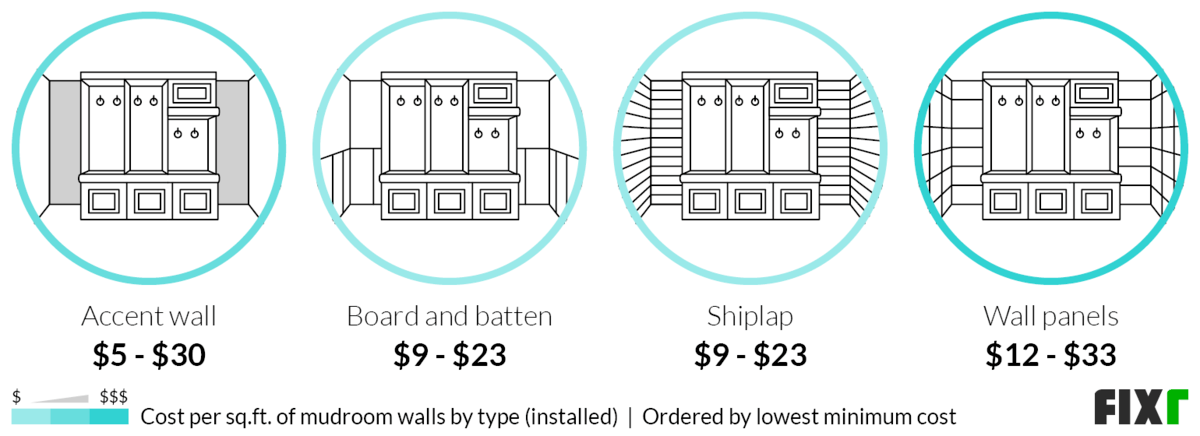
| Wall Type | Cost per Sq.Ft. (Installed) |
| Accent Wall | $5 - $30 |
| Board and Batten | $9 - $23 |
| Shiplap | $9 - $23 |
| Wall Panels | $12 - $33 |
Mudroom Accent Wall
Creating an accent wall in a mudroom costs $5 to $30 a sq.ft. Accent walls are also called feature walls because they add a decorative aspect. You can create one using nearly any material or color if it contrasts or stands out from the room. You can create an accent wall with paint in a bold color. You can use reclaimed wood, wall paneling, beadboard, or another feature. The key to creating a good accent wall is to ensure it is free of storage or clutter and readily apparent from where you enter the room.
Board-and-Batten Mudroom
The cost to create a board-and-batten wall in a mudroom is $9 to $23 a sq.ft. Board and batten is used primarily as a siding type and was one of the first types of siding used in the U.S. It is made using wide boards installed vertically to cover the walls. A thin strip of wood called a batten is fastened over each seam between the boards. The batten helps make the walls airtight. Board-and-batten walls can be made from many materials, including wood, fiber cement, and vinyl.
Mudroom Shiplap Wall
The cost of a shiplap wall averages $9 to $23 a sq.ft. Shiplap is another style that was created as a siding. It is made of “horizontal lap” or overlapping boards to create an airtight surface. In this case, the boards overlap behind one another rather than in front. This creates a smooth and tight finish for the walls with no shadows. Shiplap is typically made of wood and must be hand-fit to the walls.
Mudroom Wall Panels
Installing wall panels in the mudroom costs $12 to $33 a sq.ft. There are many wall panel types, including simple wood, beadboard, and elaborate overlay panels. Panels in the mudroom may be installed as wainscoting to a chair rail or shoulder height. They may be used to protect the walls when paired with coat hooks and other storage types. Or, they can create an accent wall. The more elaborate the wall panel and the more of the walls it covers, the higher the costs.
Mudroom Countertops
If your mudroom is large enough, you may want to consider adding counter space. Countertops provide additional storage and make it easier to fold and sort belongings or drop off bags and groceries when you enter. Most materials are suitable for this, depending on what you plan on doing in the mudroom and how you use the countertops. This includes stone countertops like granite and manmade materials like quartz and laminate. Below are common countertop materials that may be used in the mudroom and their average costs.
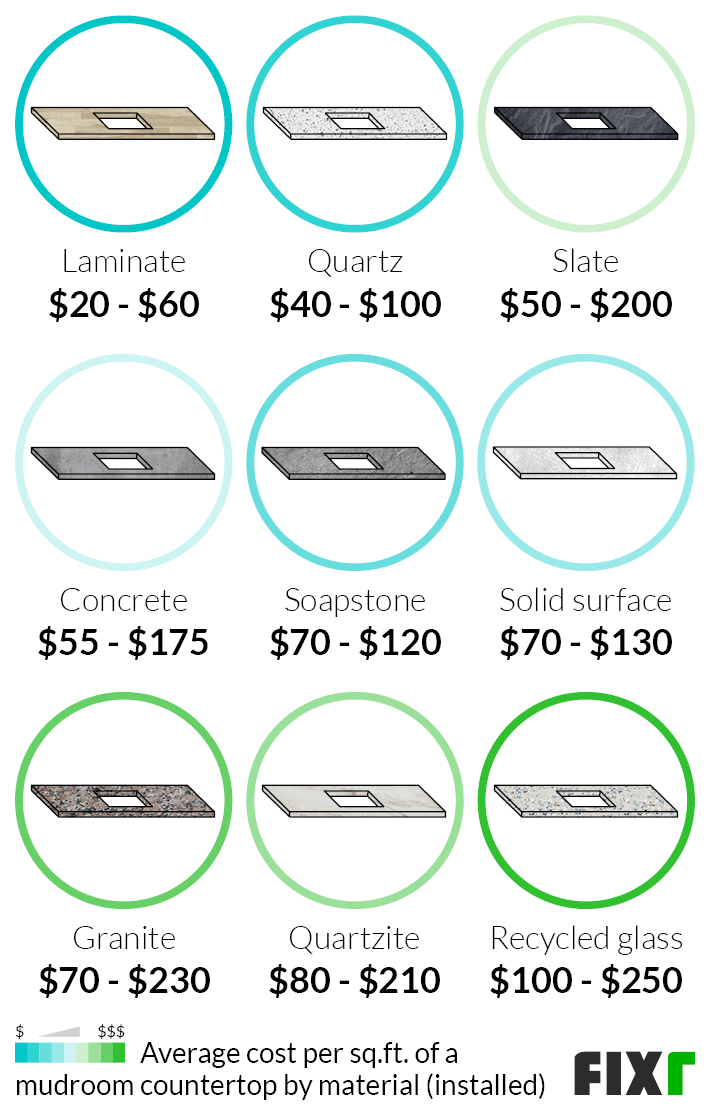
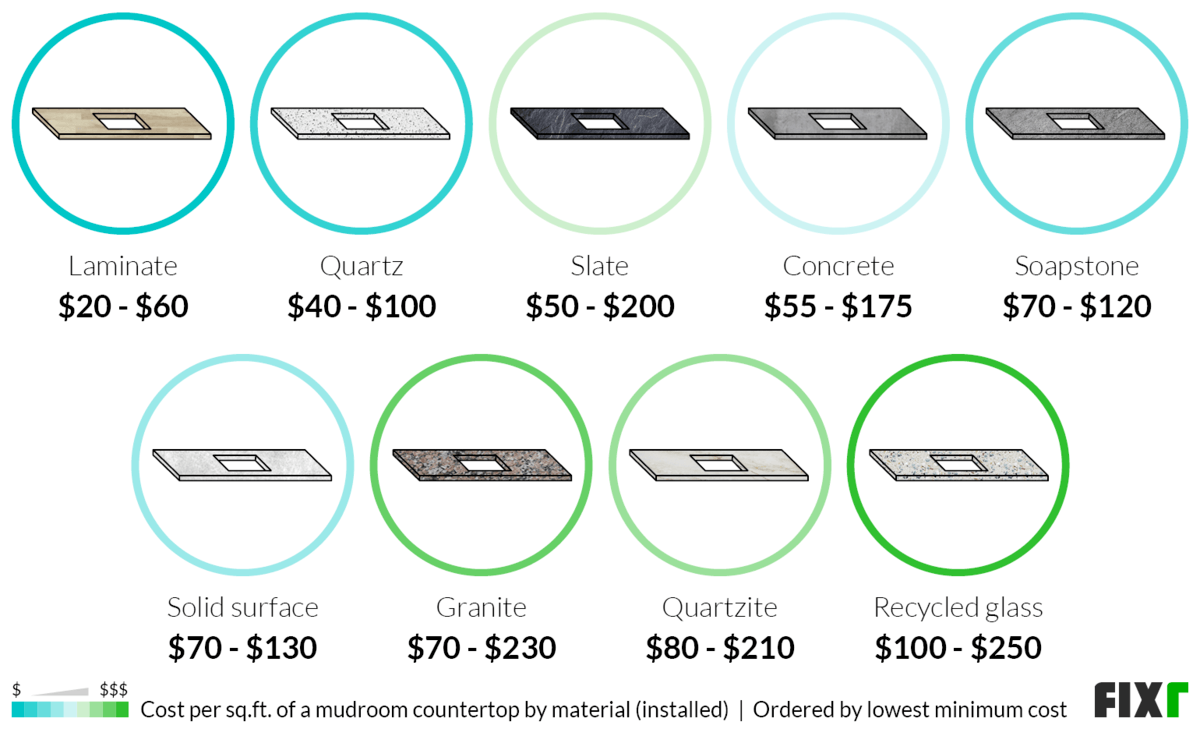
| Countertop Material | Costs per Sq.Ft. (Installed) |
| Laminate | $20 - $60 |
| Quartz | $40 - $100 |
| Slate | $50 - $200 |
| Concrete | $55 - $175 |
| Soapstone | $70 - $120 |
| Solid Surface | $70 - $130 |
| Granite | $70 - $230 |
| Quartzite | $80 - $210 |
| Recycled Glass | $100 - $250 |
Cost to Build a Mudroom
Construction costs for an exterior mudroom addition are between $25 and $60 per sq.ft. This is for the framing, exterior finishing, interior wall finish work, electrical work, and insulation. It does not include flooring, HVAC, storage, specialty wallcoverings, or plumbing. The construction process for a mudroom addition is similar to most home additions. The biggest difference is that most mudrooms are so small they are considered micro additions. Like other additions, the plans are submitted for permits, and a foundation or concrete pad is poured. The walls are framed, and the exterior of the addition is completed in materials matching the home. Some mudrooms are insulated and connected with the existing HVAC system in the home, increasing costs. Others are given a separate system like a baseboard heater, making the construction process less costly and invasive.
Additional Mudroom Storage Price
You can include storage and organization in your mudroom in many ways. Shoe racks and coat racks can be combined with lockers, while others may be stand-alone options. Mudroom shoe racks usually consist of many small cubbies and come in various sizes, allowing you to easily fit all your family’s shoes. Mudroom coat racks come in many types, from a single row of hooks to a more elaborate setup with cubbies or lockers. The more elaborate this becomes, the higher the total cost. A mudroom pantry normally operates like a stand-alone kitchen pantry in that it is typically a large closet that may have a door that pulls out for shelf access. Finally, a mudroom sink cabinet is necessary if you have many sinks. This is a stand-alone furniture piece like a kitchen or bathroom sink cabinet that can be used to store things below the sink. Depending on how you use the space and where it is located, you may include some of these common additions.


| Storage Type | Unit Cost (Installed) |
| Shoe Rack | $20 - $200 |
| Coat Rack | $20 - $1,400 |
| Pantry | $300 - $3,000 |
| Sink Cabinet | $300 - $3,800 |
Cost to Build a Mudroom Bench
You may want benches even if you do not have cubbies or lockers installed. A bench may be as simple as an elongated chair or more complex with a lift top and storage inside. Benches can be part of a larger storage system, with a coat rack and hooks behind it or cubbies below the seating. They also come in a range of materials and styles. You can find ready-made benches from many sources or build a custom bench for $165 to $500 a linear foot.
Many mudroom benches are designed to solve storage problems. For example, a mudroom bench with shoe storage gives you a place to sit while you take off shoes, allowing you to store them immediately. A mudroom bench with hooks may have a taller back designed for coat storage. A mudroom bench with drawers can store many items from hats and gloves to phone chargers and provides seating, while a mudroom bench with cubbies gives you quick access to the things below. Below are the average costs per piece for prefab items and per linear foot for custom.
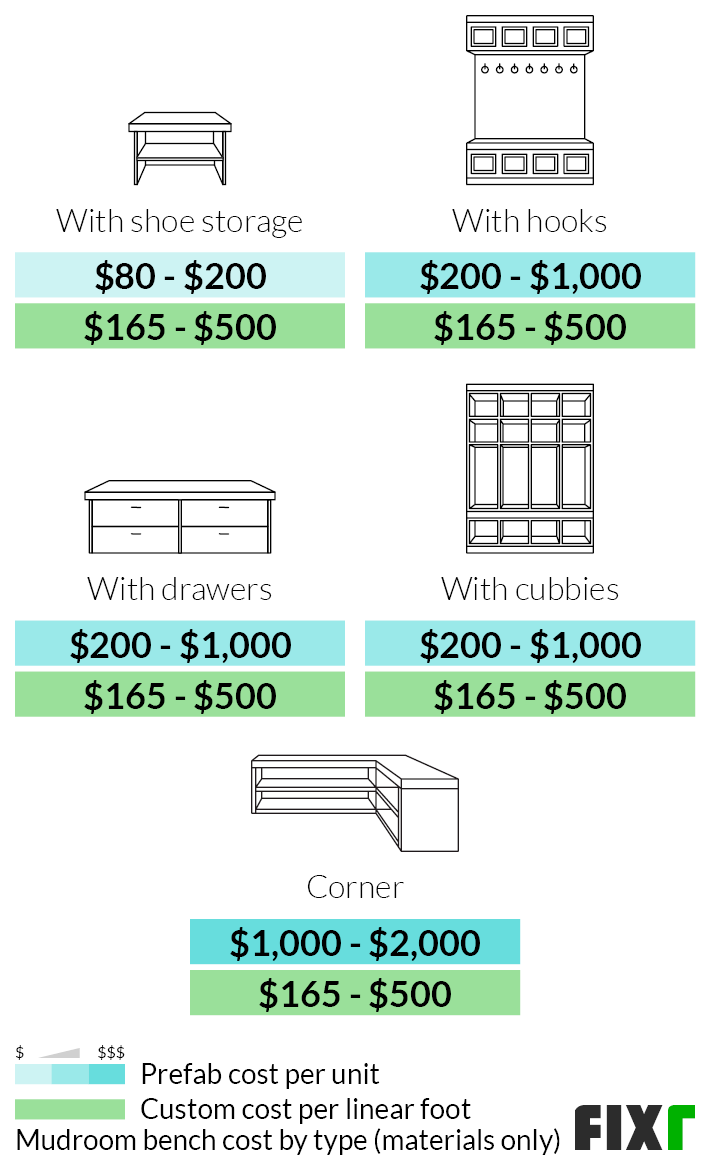
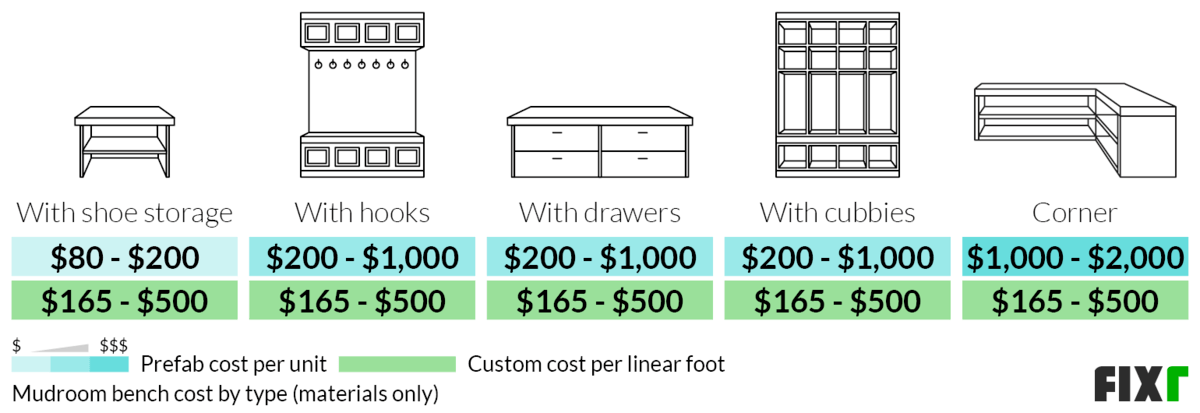
| Bench Type | Unit Cost (Prefab) | Cost per Linear Foot (Custom) |
| With Shoe Storage | $80 - $200 | $165 - $500 |
| With Hooks | $200 - $1,000 | $165 - $500 |
| With Drawers | $200 - $1,000 | $165 - $500 |
| With Cubbies | $200 - $1,000 | $165 - $500 |
| Corner | $1,000 - $2,000 | $165 - $500 |
Mudroom Plumbing Cost
Plumbing is not a necessary component of every mudroom but can add much-needed function. Some mudrooms use a sink and mudroom faucet for a quick wash when entering. Others may have a full shower or mudroom dog shower for more intensive cleaning. Common items include a mudroom or utility sink that is deep enough to hold items with a faucet tall enough to fit things beneath it. Dog showers are more common than mudroom showers for people. This is because the dog shower can be a waterproofed area with a nozzle and clips to restrain the dog, so it does not use as much space. Mudroom showers must be at least 36” square, so most people install small stall showers to save space. However, this can mean your mudroom needs to be much larger to accommodate the plumbed area and other accouterments like additional storage or non-slip flooring. Adding these features may increase the space size.
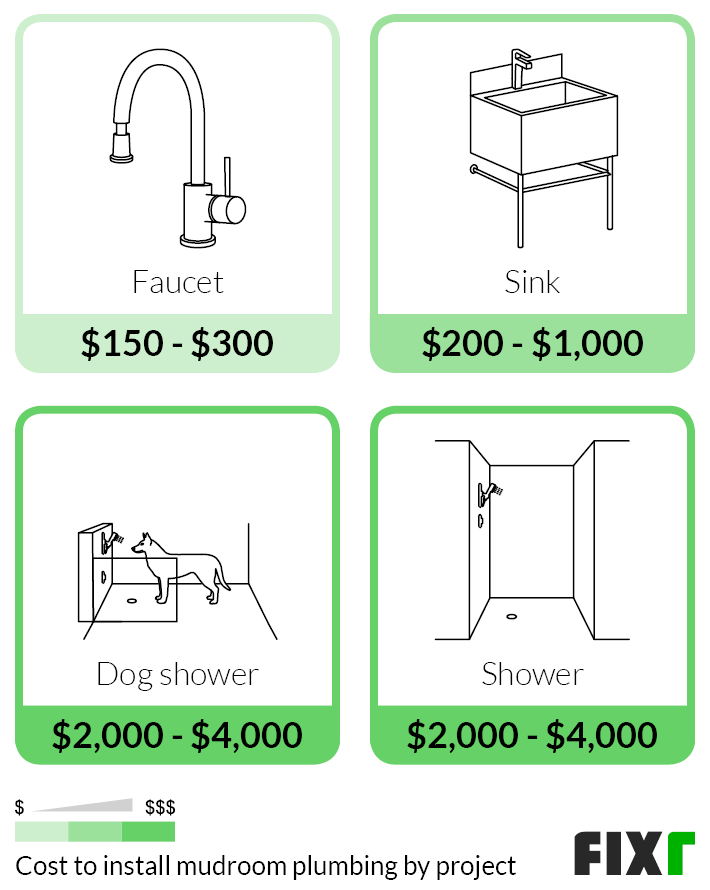
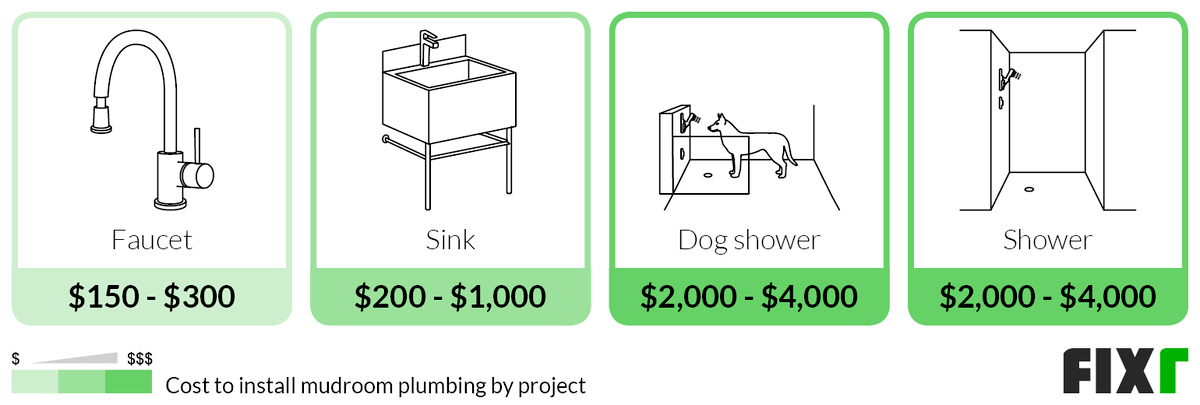
| Plumbing Item | Unit Cost (Installed) |
| Faucet | $150 - $300 |
| Sink | $200 - $1,000 |
| Dog Shower | $2,000 - $4,000 |
| Shower | $2,000 - $4,000 |
Cost to Build Mudroom Lockers
Lockers or cubbies are a frequent addition to today’s mudroom. A locker or cubby is typically assigned to each family member, providing everyone with a spot to store belongings. The lockers may be open or closed and have hooks, shelves, drawers, or small benches. You may purchase ready-made lockers to install or opt to have lockers custom built to fit the room dimensions and your needs. A basic set of 3 to 4 open lockers costs $800 to $2,400 for prefab designs, depending on the style, dimensions, and material. Custom lockers have different costs but allow you to alter the setup to fit your home and family. For example, you may include outlets for charging electronics or special shelves for holding athletic equipment. Below are the average costs for custom lockers per linear foot and prefab lockers per unit, depending on their type.

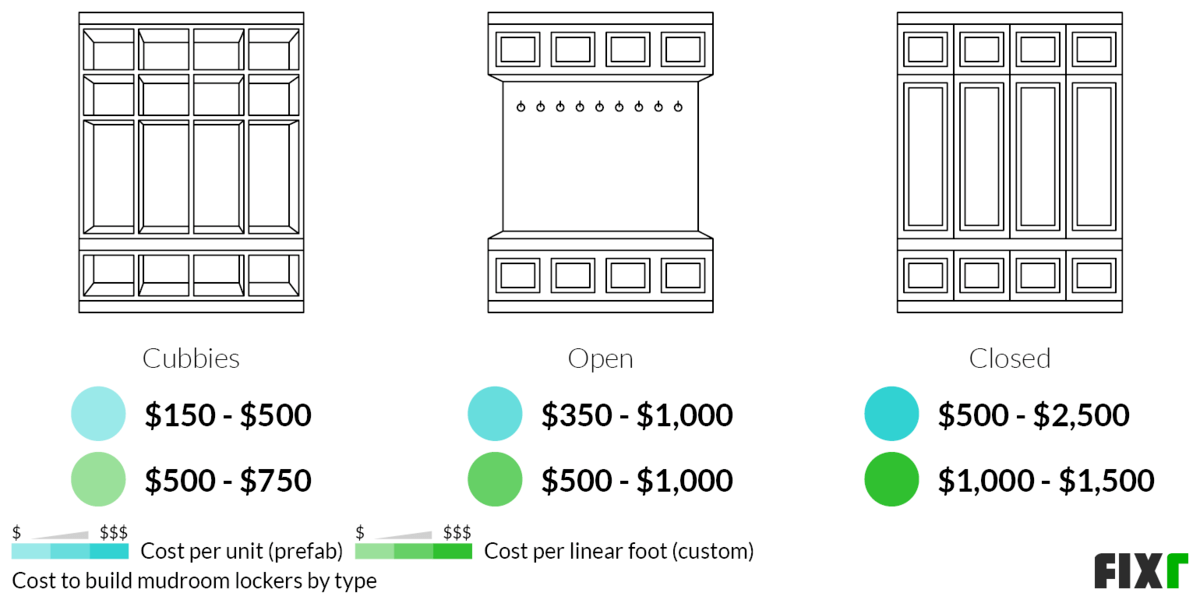
| Type of Locker | Cost per Unit (Prefab) | Cost per Linear Foot (Custom) |
| Cubbies | $150 - $500 | $500 - $750 |
| Open | $350 - $1,000 | $500 - $1,000 |
| Closed | $500 - $2,500 | $1,000 - $1,500 |
Mudroom Cubbies
The cost of mudroom cubbies ranges from $500 to $750 a linear foot for custom cabinets and installation. The cost of prefab cubbies is $150 to $500 per total unit. Cubbies are essentially smaller lockers or cabinets. If you do not need a big set of storage lockers, smaller cubbies can sometimes be an option. Cubbies come in several sizes, from small squares that can be hung at a child’s height to large open cabinets with 1 or 2 shelves and hooks. Cubbies tend to be simpler and plainer than a locker. They pair well with baskets and other organizers you can arrange inside.
Open Locker
The cost of custom open lockers for the mudroom is $500 to $1,000 a linear foot. The cost of prefab open lockers is $350 to $1,000 per unit. Low costs may include 1 to 2 lockers, while higher costs may have 3 to 4. These lockers are more like elongated cubbies, which have hooks for hanging coats and may contain shelves and plugs for electronics. They may be mostly open but have a small pull-out drawer at the bottom or a small door at the top to contain items. Open lockers have more options than cubbies, and they are frequently wider. They may be built with a bench at the bottom, adding more storage and seating.
Closed Mudroom Locker
The cost of a custom closed mudroom locker averages $1,000 to $1,500 per linear foot installed. The cost of prefab closed lockers is $500 to $2,500, with low costs being for 1 to 2 lockers and higher costs having up to 4 lockers in a row. Closed lockers are essentially large cabinets with doors that shut. They may also contain hooks, shelves, plugs, and drawers, but anything inside is hidden from view when the doors are closed. This can be helpful for some households because it produces a more ordered appearance, even if a child’s locker is not tidy. Like cabinets, closed lockers have a range of door styles. You can find some with two stacked doors or a door and drawer for more customization.
Pros and Cons of Adding a Mudroom
Mudrooms add many benefits. They are typically the informal entry, so they become a likely place to bring pets and children through. They are also a good area to organize and store coats, boots, and outdoor equipment like sports gear, snow clothes, or gardening tools. Mudrooms are usually easy to clean and care for so that dirty shoes or pets do not leave lasting damage.
Adding a mudroom means taking space in the home or altering your house’s footprint. Both scenarios have drawbacks. Converting existing space means removing an area that might already have use and reallocating other spaces.
Changing the footprint means making sure the exterior matches, which can be expensive and may mean applying for special permits, depending on your area. For example, in some ordinances, you cannot add a space too close to your property lines, or you may not be able to make the new addition as tall as you want.

Laundry Room and Mudroom Combo
You can sometimes combine a mudroom with a laundry room. This saves space in smaller homes, particularly when converting an existing space. Most laundry rooms start at 30 sq.ft. and most mudrooms start at 36 sq.ft. Combining them could mean these smaller spaces do not have enough room for everything in one area. For this reason, it is recommended that you double the size to a minimum of 8’ x 8’ or 64 sq.ft. to ensure you have enough space.
Laundry rooms and mudrooms share many things, including storage and a need for water and stain-resistant flooring. The costs per square foot do not change dramatically when combining a laundry room with a mudroom and have an average range of $6,400 to $19,200. If you do not opt for a full laundry room/mudroom combination, you can still add a washer and dryer to your mudroom. Many mudrooms already have the storage and water-resistant flooring a laundry room needs. The average cost to install a new washer and dryer is $850 to $2,500.
Enhancement and Improvement Costs
Mudroom With a Refrigerator
The mudroom can also be a good place to keep a second refrigerator. This can be a useful option for many families, whether it is just a small fridge for drinks or holding school lunches or a full-sized second fridge. The average cost of a new refrigerator is $1,000 to $3,000.
Radiant Floor Heating
If this is a mudroom addition, you may want to consider radiant floor heating as a good option for warming the space. Electric floor radiant heat can be a good option for additions because it does not have to connect with the HVAC system. The average cost is $10 to $25 a sq.ft.
Additional Considerations and Costs
- Colors. While mudrooms can be any color, the most common colors are white, brown, beige, and gray.
- Maintenance. Mudrooms are designed to be easy to maintain. Choose materials that can be quickly wiped to keep the space looking great.
- Location. Not everyone uses a mudroom. They are meant to be the main entrance for the family from the outdoors. Pay attention to its location. The space is wasted if it is far from where you usually enter.
- House value. Adding a mudroom increases your home size and value. Note the size and placement of other mudrooms in your neighborhood to ensure yours adds value.
- Door. It is usually recommended to install an energy-efficient door between the mudroom and home to keep outside air from your main living area.
- Permits. You need a permit in most areas to build a mudroom onto your home. Check with your local municipality for costs and details.
- DIY. For mudroom conversions, you may be able to do some of the work DIY, particularly if you use ready-made furniture, such as benches and wall cubbies you can hang. Building a full mudroom addition is not recommended for DIY.
- Prep work. Due to the amount of prep work involved, your project may not begin for 6 to 12 weeks until all items have been selected and ordered. Speak to your installer if you are on a tight timeline.
FAQs
- Does a mudroom add value?
Yes, especially mudroom additions because they increase your home’s total square footage.
- How much does it cost to add a mudroom?
The average cost to add a mudroom is $12,000 to $18,000, depending on the size and style.
- How much does it cost to build a mudroom bench?
A custom mudroom bench ranges from $165 to $500 per linear foot, depending on the bench style and materials.
- What is the best flooring for a mudroom?
The best flooring for a mudroom is easy to maintain, non-skid, and hides dirt. Porcelain, slate, bluestone, quarry pavers, and some forms of engineered hardwood make good options for mudrooms.
- What is a good size for a mudroom?
Mudroom sizes start at around 36 sq.ft. Most families find 50 to 100 sq.ft. sufficient.
- What should a mudroom include?
This varies depending on your family’s needs, but most people install easy-to-care-for surface materials, storage like cubbies or lockers, and benches and places for shoes and outdoor belongings.
